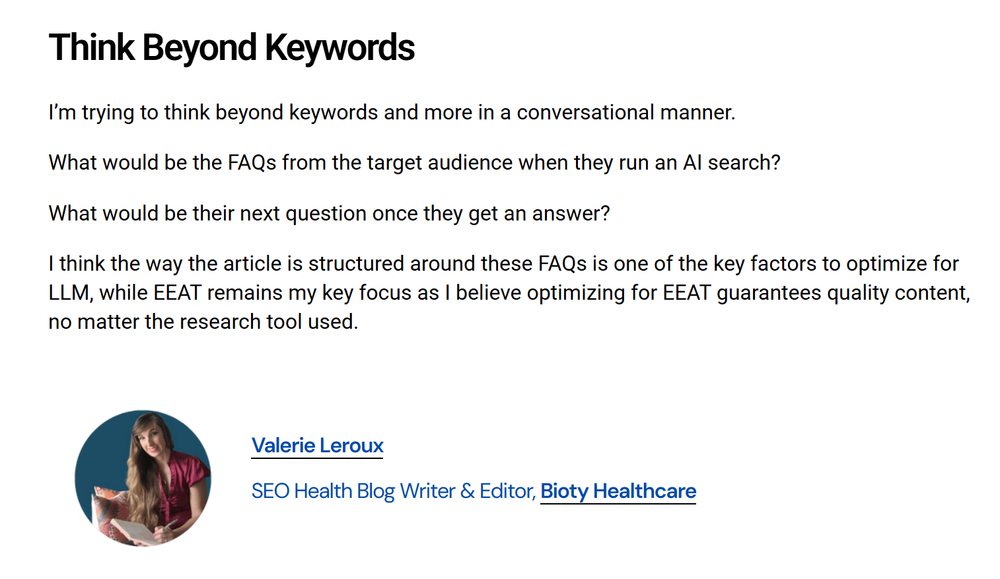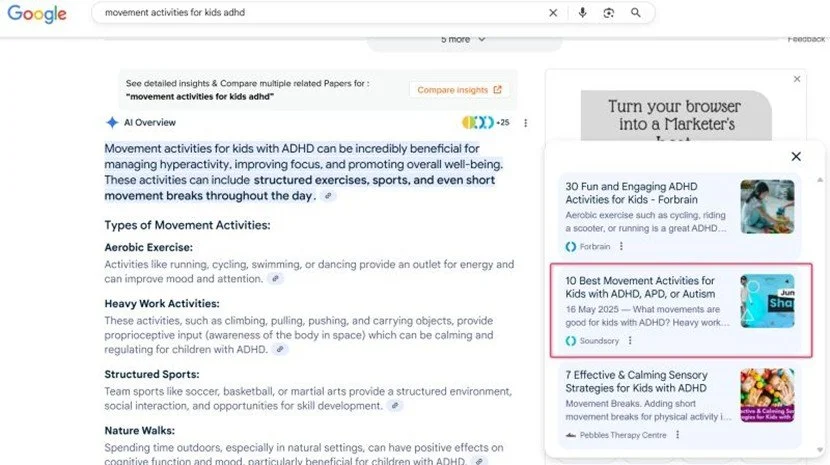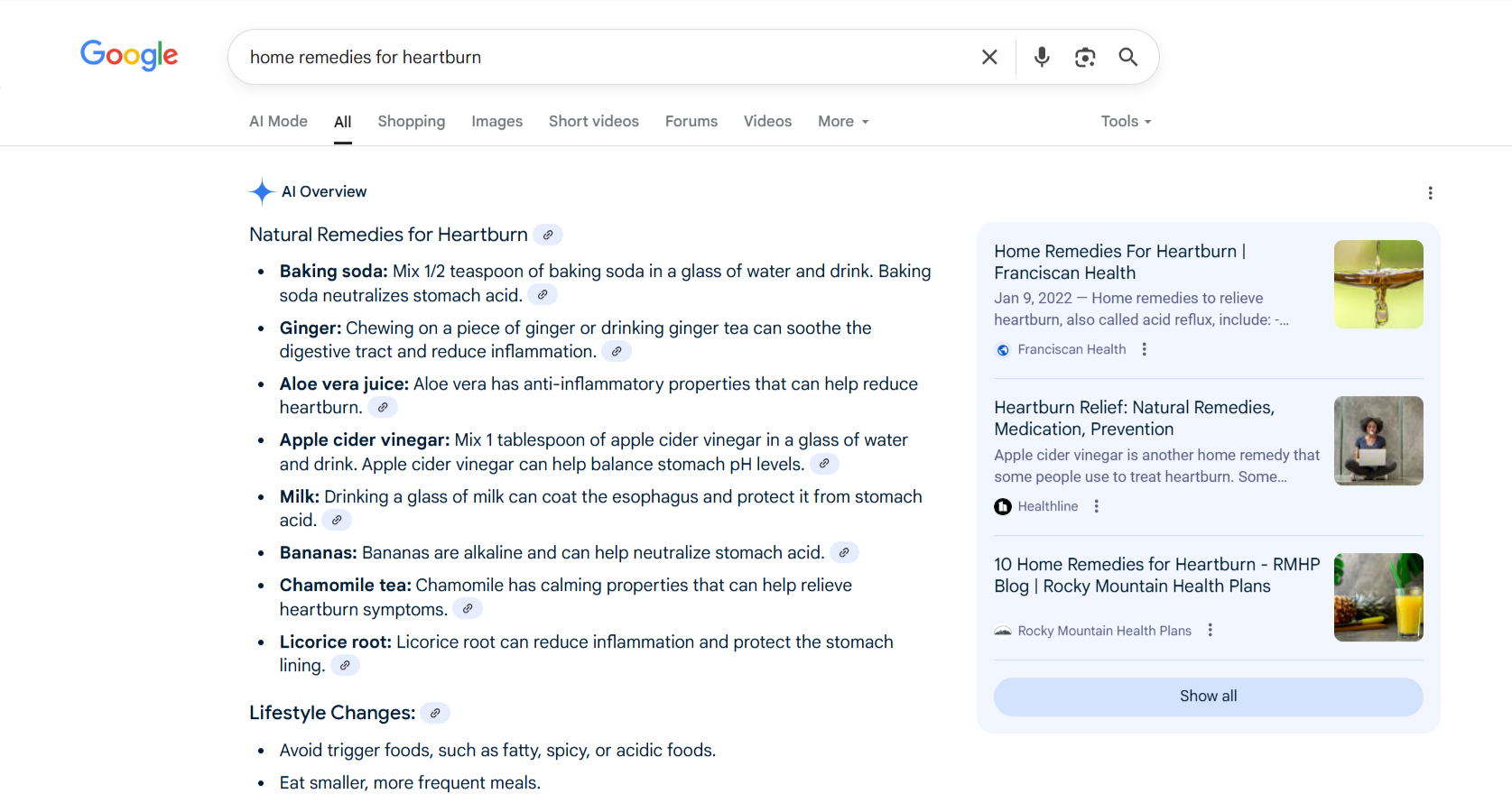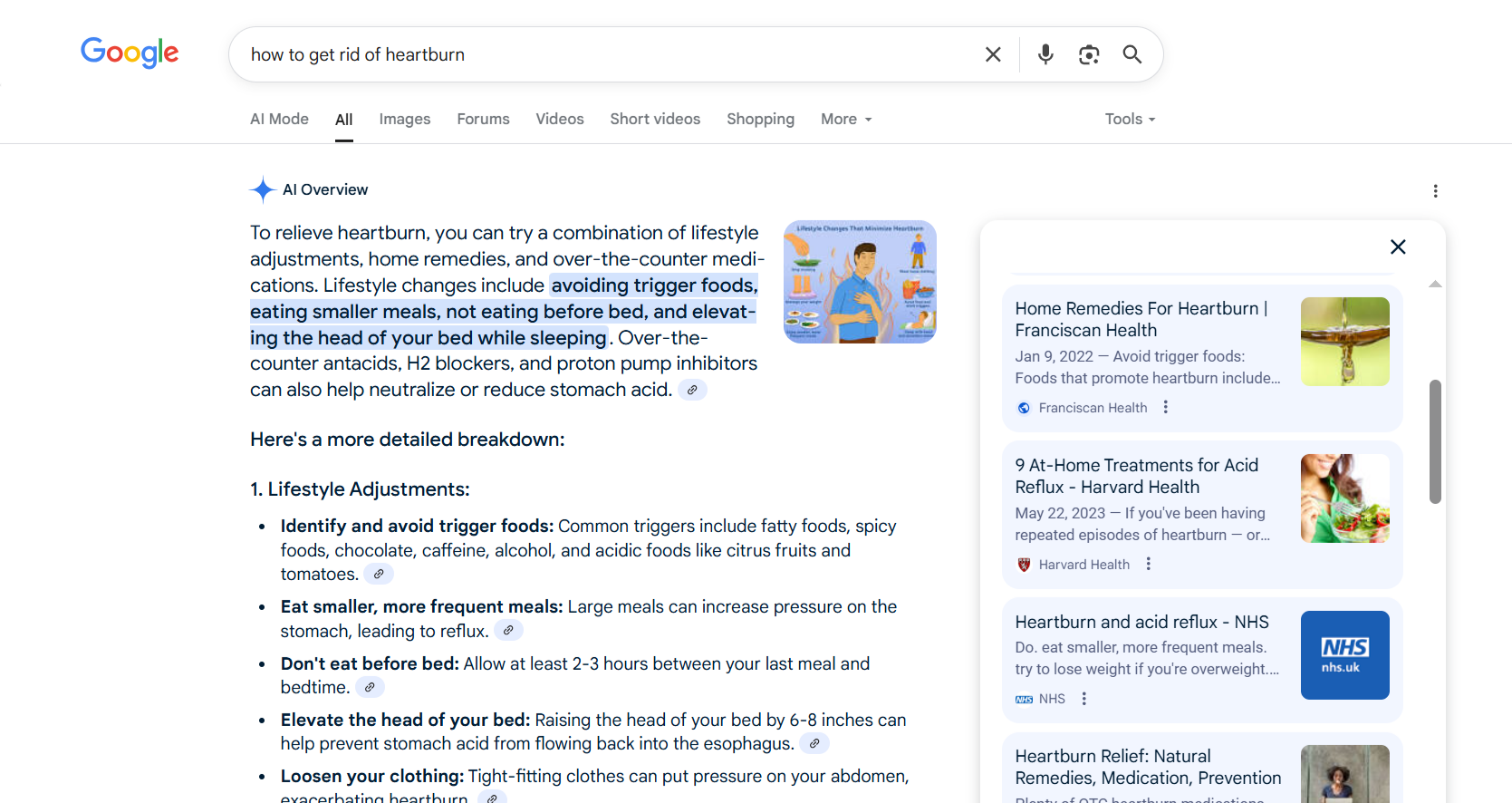How to Get Featured in AI Overviews: What I Learned from Real Health Brands
If you’re a health business that relies on blog content to build trust, you’ve likely noticed some changes in how people are finding and interacting with your content. With Google’s AI Overviews now reaching over 1.5 billion users each month (Alphabet, Q1 2025), it’s natural to wonder how your blog still fits into the picture.
AI Overviews are summaries generated by Google’s AI that pull answers from multiple trusted websites to quickly respond to users’ questions at the top of the search results, often before they click on anything.
In this article, I’ll walk you through how I’ve seen health brands show up in AI Overviews by blending best SEO practices with what works for AI. You’ll see real examples, a simple 6-step framework to follow.
TL;DR: How Health Brands Can Get Featured in Google’s AI Overviews
Understand human search intent: Use conversational, question-based keywords to match how people actually search today.
Combine SEO + AEO: Traditional SEO builds visibility; AEO (Answer Engine Optimization) helps your content become the answer AI Overviews select.
Prioritize EEAT: Highlight Experience, Expertise, Authoritativeness, and Trust (especially critical in health).
Structure for AI:
Use clear headings and lists
Include TL;DR sections and FAQs
Add schema markup if this wasn’t already done - AI loves them!
Build brand mentions: Citations and mentions across the web (not just backlinks) help Google recognize and cite your brand.
Informational content still matters: Blogs are often the foundation of what AI Overviews pull from and are helpful to create topical authority — don’t stop creating!
Monitor results: Track your citations in AI Overviews in incognito mode while you should see impressions rising in your Google Search Console.
6-Step Framework to Integrate AEO with SEO (For Health Businesses)
Here’s the framework I am using to help you show up in Google’s AI Overviews while still performing well in traditional search.
1. Start with Real Questions People Are Asking
AI Overviews often pull from content that answers specific, conversational questions. These are usually longer-tail searches like: How do I know if I’m entering perimenopause?
To find these questions:
Ask your customers (highly underrated technique)
Check the People Also Ask box in Google
People Also Ask section for the keyword “magnesium in pregnancy” showing questions people are searching for.
Look at Reddit threads, Facebook groups, or Quora
The way I build my own blogs is based on the questions I receive from clients and mentees, then I find a matching keyword to still optimize them for SEO as well.
2. Optimize EEAT Signals
In health, trust is everything. Google and AI tools are looking for content with real Experience, Expertise, Authoritativeness, and Trust (EEAT).
Show it by:
Adding author bios with credentials (e.g., "Certified nutritionist with 10 years experience")
Linking to trusted sources in your country like NHS in the UK, CDC in the US, etc.
Quoting experts or clinicians in your field.
Using first-hand experience when appropriate (especially helpful for wellness blogs).
3. Format Your Blog for Humans and AI
Structure matters for readers who skim, and for AI systems that parse your content. Here’s what works:
Put a summary at the top — answer the question in 2–3 lines or with bullet points
Use bullet points and numbered lists (exactly what I’m doing here)
Add a definition block if relevant
Use H2 and H3 headings to break up the page
4. Use Schema Markup Built for Health Content
Schema helps AI understand what your blog is about — think of it as labels for your content.
Use:
FAQPage for your Q&A sections
MedicalEntity for posts about conditions or nutrients
Product for supplement or device content
HowTo for step-based guides
Tools that make it easy for non-developers:
Creating schema markups for free: Merkle Schema Generator.
These days, I use ChatGPT Plus to generate schema markups.
5. Build Brand Mentions (Not Just Backlinks)
AI tools don’t always need a link to recognize your brand. They look for brand mentions across the web.
Here’s how health brands can build brand mentions:
Share your own insights or mini surveys. For example, a wellness clinic could run a small poll on magnesium use and share the results in a blog or infographic.
Syndicate your blog content on platforms like Medium, Substack, or even health-focused newsletters. Share an excerpt or summary with a link back to the original so that it doesn’t hurt your SEO.
Get quoted in expert roundups. Use HARO, Qwoted, Featured to pitch yourself or your health professional network for interviews and media mentions.
Guest post on reputable health sites. These could be niche blogs, wellness brands, or practitioner websites. If they mention your brand, Google’s AI can notice.
Collaborate with health influencers. One of my clients collaborated with a dentist influencer to answer questions in videos.
As an SEO mentor to writers, I’ve also been working on my own brand mentions – for instance here:
Example of article where I shared my insights
6. Track What’s Working
As with SEO, we want to track results and check the visibility we have for top keywords. But with AEO, it’s complicated because AI Overviews are dynamic and personalized. SEO professionals are still trying to find a way around this.
Here’s what I’ve done so far:
I checked Google Search Console for ranking and click data - unfortunately at this point in time it’s not possible to dissociate impressions coming from AI Overviews from the rest, but they do appear as part of your impressions. I hope Google will come up with a solution.
I searched top keywords in incognito mode on Google to see if my clients are cited in the AI Overviews
Alternatively, there are third-party tools like Semrush, Ahrefs, SE Ranking AI Overview Trackers, or Ziptie, but I haven’t tested them myself for now.
The idea is to track patterns: which types of posts get picked up, what format works best, or which authors drive the most trust.
Real Examples: How Health Content Gets Picked Up by Google’s AI Overview
Let’s look at real health articles that are now featured in Google’s AI Overviews.
One is from a small health blog. The other is from a major hospital. Both followed the same core principles: clear structure, natural language, and expert-backed content.
Real Example #1: How a Health Blog Outranked Big Brands in AI Overview
Here is an example of a blog post I worked on which was featured in Google’s AI Overview — even though it was written before AI Overviews existed.
Example of AI Overview for the query “movement activities for kids ADHD” showing my client’s blog as a trusted source.
That’s proof that content built on strong SEO and EEAT foundations can still get picked up by AI tools, especially when it’s genuinely helpful and answers what people are really searching for.
The blog was a guide to movement activities for kids with ADHD, written in collaboration with health writer Rachel Ann Melegrito. I created the content brief and edited content as the SEO editor.
Here’s what worked:
The post is stuffed with examples of Experience and Expertise, two pillars of EEAT.
For example, the intro includes a personal, trust-building statement:
“With years of experience working with kids, I know how important it is to choose activities that are both fun and helpful.”
2. The structure made it easy for AI to understand:
A short, clear introduction
Subheadings that broke down different activity types and are based on questions from the audience
Bullet lists with practical examples like aerobic exercises and nature walks
A simple FAQ section with question-based headings and direct answers
Even though the site isn’t a major health publisher, that post showed up in the AI Overview above Healthline and ranked #5 in organic search just one month after publishing.
This shows that clear structure, conversational tone, and expert-backed content can help smaller health brands get visibility in AI results.
Real Example #2: How a Major Health System Increased AI Overview Visibility
Since most of my clients tend to be small health businesses, I asked Robbie Schneider, Social Media Manager and Content Marketing Leader at Franciscan Health in the US, to share some examples of how a larger health brand is showing up in AI Overviews.
Example of AI Overview for “home remedies for heartburn” showing Franciscan Health as one of the trusted sources
She explained that their focus on addressing patient concerns with plain language and a conversational tone has led to massive growth in AI Overview visibility.
Robbie Schneider
“Our blog’s owned listings in AI Overviews are 1,000x higher than several of our competitors — including major academic medical centers in our region.”
How are they doing it?
Robbie says that they align every piece of content with real patient questions, using:
Everyday language people actually search for (e.g., “first signs of perimenopause”)
Keywords with medical context like “menstrual cycle,” “heartburn relief,” and “perimenopause age”
Expert-backed advice from clinicians (especially in competitive topics like gastroenterology)
Two featured examples from the Franciscan Health:
First Signs of Perimenopause
Competing in a crowded space, they optimized for terms like perimenopause age and menstrual cycle, while addressing the exact questions users search for (e.g., when symptoms start, what to expect).Home Remedies for Heartburn
By combining expert commentary from a gastroenterologist with long-tail keyword targeting, they’re now outranking heartburn products and national publishers in AI Overviews for searches like “how to get rid of heartburn”.
Example of AI Overview for “how to get rid of heartburn” showing Franciscan Health as one of the trusted sources
What these examples of early success in AI Overviews prove to me:
AEO rewards relevance, clarity, and trust.
Conversational tone + clinical credibility = visibility.
Both small blogs and hospital systems can win with the same approach:
Speak to real questions
Use natural language
Support answers with expert insight and boost trustworthiness signals (EEAT)
Structure for clarity
Instead of choosing one over the other, smart health businesses are adopting a hybrid approach:
Summaries + Authority → Provide quick answers up top, then deeper content that earns authority and backlinks.
Schema + Content Depth → Use FAQ and MedicalEntity schema, but also publish well-researched, long-form health articles when users are asking for it.
Conversational Keywords + Clusters → Answer patient-style questions, while clustering supporting blogs for topical authority.
EEAT Proof → Show author credentials, cite studies etc.
This way, health brands are becoming the source that readers trust (most importantly), and that both Google Search and Google’s AI recognize and trust as well.
Final Thoughts: Are AI Overviews a Threat to Health Blogs — or Your Biggest Opportunity Yet?
AI Overviews aren’t here to kill your blog traffic, but they’re changing how people discover and trust your brand.
For health businesses, this shift can work in your favor — if you understand five things when it comes to content:
Human search intent is more important than ever. AI Overviews answer real questions, not just keywords. When your blog mirrors how people think and speak, AI sees your content as helpful.
EEAT (Experience, Expertise, Authoritativeness, Trust) is non-negotiable in health. AI tools pull from sources that show real credibility, not AI-written fillers.
Answer-first formats: Start with a summary, then go deeper (like what I did in this article).
Conversational + clinical: Speak like your patient and back it up with real expertise.
SEO + AEO together: It’s not a choice between the two — you need both to build trust and visibility. As with SEO, you’d need to have identified your brand positioning and figured out how you differentiate yourself to attract the right people and escape competition.
You don’t need AI tricks or hacks. You need real answers, written for real people. If anything, that’s what health businesses should do best.
Do you know if your blog is optimized for AI Overviews?
If you're wondering whether your content meets the highest EEAT standards, I offer mini content audits for health businesses.
You’ll get personalized, practical recommendations to help your blog show up in AI Overviews and support your wider SEO and brand goals. Submit your contact details below and I’ll be in touch 👇🏼
Val ✍🏼
FAQ: How to Get Featured in Google’s AI Overviews (For Health Businesses)
-
To be featured, your content needs to combine traditional SEO fundamentals (such as strong EEAT and satisfying the human search intent) with AEO tactics like question-based headings and concise summaries (TL;DR). In health, citing reputable sources (e.g., clinical studies, CDC) and having expert author bios greatly improves your chances.
-
To get your content cited by Google’s AI overview, start with question-led keyword research (use Google’s “People Also Ask,” Reddit, and forums), then structure your posts with short answers, bullet points, and clear definitions satisfying the search intent. Ensure your content is EEAT-optimized. I now tend to format health blogs like FAQ hubs to mimic a conversation the reader would have with AI, and which AI systems love.
-
Humans do not write AI Overviews. They’re generated by Google’s Gemini AI model, which pulls from multiple indexed websites, fact databases, and Google’s Knowledge Graph. The model doesn’t “author” the content; it summarizes existing information. That’s why the credibility and structure of your health content directly impact whether your site gets cited. That’s also why health misinformation could spread pretty badly if no one cares to create accurate health content – AI is only remixing existing content and cannot evaluate medical accuracy properly.
-
They increase brand visibility but also raise the number of zero-click searches. Instead of seeing this as lost traffic, health brands can turn AI mentions into opportunities to get higher-intent traffic. In fact, being cited often builds more trust than a standard ranking because it positions your site as the trusted answer.
-
AI Overviews can be a good opportunity for health businesses, if you’re prepared for them. AI Overviews can level the playing field by showcasing niche health content from smaller sites, as long as they’ve worked on their topical authority and their content meets EEAT standards, which can’t be achieved when using AI-generated copy. I’ve seen small health e-commerce brands cited alongside big names because their content was well-structured and authoritative, even though they ranked below those big brands in traditional search (but were still high ranking).
-
Yes, AI Overviews can be wrong and occasionally present outdated or incomplete health information. As they don’t always show sufficient context nor empathy, they can contribute to health misinformation and increase health anxiety. This risk grows if health businesses and publications stop producing accurate educational content — because AI Overviews rely entirely on existing content and cannot assess medical accuracy properly. That’s why health brands that consistently update their blogs with trustworthy, helpful information are more likely to stay cited and trusted in AI results.
About the Author
Valérie Leroux, MSc, is a bilingual SEO health writer and founder of Bioty Healthcare since 2022, helping health brands and medical writers create high-ranking, trustworthy content backed by science and empathy.






